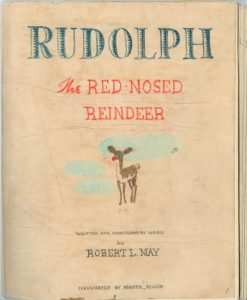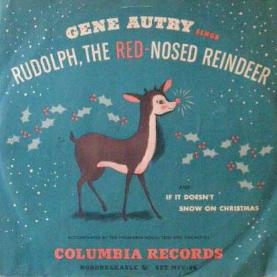
When Clement Clarke Moore penned his famous poem “A Visit from St. Nicholas” in 1823, he named eight reindeer that pull Santa Claus’s sleigh:
More rapid than eagles his coursers they came,
And he whistled, and shouted, and call’d them by name:
“Now, Dasher! Now, Dancer! Now, Prancer, and Vixen!”
“On, Comet! On, Cupid! On, Dunder and Blixem!”¹
Fast forward to 1939, when the Chicago-based department store Montgomery Ward commissioned copywriter Robert Lewis May to author a children’s book for that year’s holiday promotion. Inspired by Moore’s poem, he created the story of a ninth reindeer, whose glowing red nose guides Santa through an unusually harsh blizzard. He considered several names beginning with “R” to play on the alliteration of a “red-nosed reindeer,” including “Reginald” and “Rollo,” but he ultimately decided upon “Rudolph.” The promotional booklet was a huge success, with over 2 million copies selling across the country.²
Following the second World War, Montgomery Ward CEO Sewell Avery gave May the rights to his story. It isn’t exactly clear why this unconventional move was made, but the struggling ad man, a widower with two children, seized on the opportunity. He handed the story over to his brother-in-law, Johnny Marks, a radio producer and songwriter. Rather than use May’s existing verses (which were set in anapestic tetrameter, just like Moore’s 1823 poem), Marks crafted new lyrics that condensed the story of Rudolph’s rise from underdog to hero down to 16 lines plus a short introduction that references “A Visit from St. Nicholas”:
 You know Dasher and Dancer and Prancer and Vixen,
You know Dasher and Dancer and Prancer and Vixen,
Comet and Cupid and Donner and Blitzen,
But do you recall
The most famous reindeer of all?
The song was pitched to country singer Gene Autry, who first showed no interest. Autry’s wife encouraged him to change his mind (wives always know best, don’t they?).³ Columbia released the recording on September 1, 1949, and by Christmas, it was a smash hit with 1.75 million copies selling by the end of the season. As a result of the success, Marks started up his own publishing company, St. Nicholas Music. He would go on to write several more classic Christmas tunes, including “Rockin’ Around the Christmas Tree” (1958, made popular by Brenda Lee) and “Run Rudolph Run” (1958, recorded by Chuck Berry; also known as “Run, Run Rudolph”).

Eventually, Rudolph made his leap to the small screen. In 1963, Videocraft International, Ltd. (later Rankin/Bass Productions) was contracted by General Electric (GE) to produce animated specials for the General Electric Fantasy Hour on NBC. The first special was the conventionally animated Return to Oz, based on L. Frank Baum’s The Wonderful Wizard of Oz, which aired in February of 1964. For the second special, Videocraft adapted May’s story and hired Marks to write additional songs. Rudolph, the Red-Nosed Reindeer aired on December 6, 1964. The hour-long stop-motion animation special significantly expanded May’s original story introduced viewers to new characters, including a snowman narrator, Sam, voiced by Burl Ives. Ives sings the title song as well as the newly composed “Silver and Gold” and “Holly Jolly Christmas.” The special was a huge success and has aired every year since (it moved from NBC to CBS in 1972), making it the longest continually running Christmas special of all time. Marks had no idea how right he was when he wrote the ultimate couplet of his entry in the American Christmas songbook:
Rudolph the Red-Nosed Reindeer,
You’ll go down in history!
¹”Dunder” and “Blixem” were the original Dutch names used by Moore, which translated to English are “Thunder” and “Lightening.” In an 1844 version, he changed them to the “Donder” and “Blitzen.” When Marks wrote the lyrics to the song in 1949, he used the correct German spelling of “Donner.”
²https://www.npr.org/2013/12/25/256579598/writing-rudolph-the-original-red-nosed-manuscript
³http://www.nytimes.com/1985/09/04/arts/johnny-marks-dies-composed-hit-song-rudolph-in-1949.html
